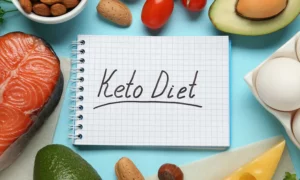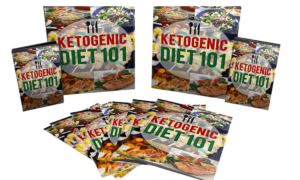The Keto Diet for Weight Loss: A Beginner’s Guide
Introduction
The low-carb, high-fat ketogenic diet, commonly referred to as the “keto diet,” has grown in favor of a strategy for weight loss and overall health improvement. The diet works by triggering a condition of ketosis in which the body burns fat instead of carbs for energy. A beginner’s approach to the keto diet for weight reduction will be provided in this article.
What is the Keto Diet?
The keto diet consists of a lot of fat, little protein, and almost no carbohydrates. The diet’s objective is to induce a state of ketosis in which the body burns fat instead of carbs for energy. To achieve this, the macronutrient ratio of the diet is typically 70-75% fat, 20-25% protein, and 5-10% carbohydrates. This ratio drastically reduces the intake of carbohydrates and increases the intake of fats.
How Does the Keto Diet Work?
The keto diet works by limiting the intake of carbohydrates, which forces the body to burn fat for fuel instead. The body creates ketones, which it utilizes as fuel while it is in a condition of ketosis. The body produces ketones when it doesn’t have enough carbohydrates to burn for energy, which happens when following a low-carb diet.
What Can You Eat on the Keto Diet?
On the keto diet, eating high-fat, moderate-protein, and low-carb foods is essential. Good fat sources include avocado, olive oil, coconut oil, nuts, and seeds. Good protein sources contain meat, fish, eggs, and dairy products. Foods to avoid on the keto diet include sugar, grains, and high-carb fruits and vegetables such as potatoes, bananas, and grapes.
Safety Considerations
It’s critical to speak with a healthcare provider before beginning the keto diet, especially if you have any medical issues. Additionally, because the keto diet might result in electrolyte imbalances, you must make sure you get adequate electrolytes including salt, potassium, and magnesium. can cause electrolyte imbalances. It’s also important to focus on nutrient-dense foods and include a variety of healthy fats, proteins, and low-carb vegetables in your diet to ensure that you get all the necessary nutrients.
Potential Challenges and Risks
Awareness of the potential challenges and risks associated with the keto diet is essential. The “keto flu,” a collection of symptoms that might appear when the body adjusts to the low-carb, high-fat diet, is one of the keto diet’s most frequent problems. These symptoms may include fatigue, headaches, nausea, and muscle cramps.
To minimize the risk of the keto flu, it’s essential to ensure you’re getting enough electrolytes and gradually reduce your carbohydrate intake over time.
Another potential challenge of the keto diet is the difficulty of sticking to the diet long-term. The keto diet can be restrictive and difficult for some people to follow. To overcome this challenge, it’s essential to have a plan in place and to find ways to make the diet sustainable for your lifestyle.
Conclusion
Conclusion The keto diet may be a successful strategy for shedding pounds and enhancing general health. However, it’s crucial to follow the diet carefully and to be informed of any hazards and difficulties it may provide. By consulting with a healthcare professional, getting enough electrolytes, and focusing on nutrient-dense foods, the keto diet can be a safe and effective way to achieve weight loss goals. With proper planning and finding ways to make the diet sustainable for your lifestyle, the keto diet can be an excellent tool for weight loss and overall health improvement.

































